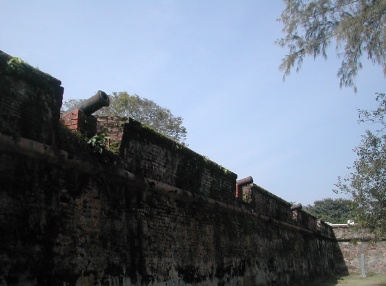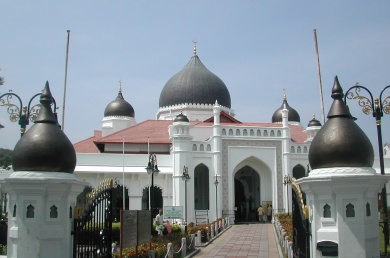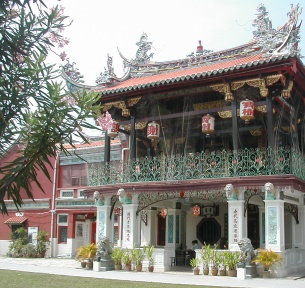PULAU PENANG
Penang, like Malaka, is rich in Malaysian history. It, too, was a ‘must see’ on our list.
Chinese seafarers were aware of the island as far back as the 15th century, and it was uninhabited at the time. An English merchant seaman, Captain James Lancaster, reported that in 1593 the island was still uninhabited jungle wilderness. The first inhabitants were probably from Sumatra arriving in the early 18th century, and the island was under the control of the Sultan of Kehah by the late 18th century.
In 1771, the sultan signed his first agreement with the British East India Company giving trading rights in exchange for military aid against Siam. Fifteen years later, in 1786, the British Captain Francis Light took possession of Penang, and the town of Georgetown was formed.
Georgetown was a duty-free port, and it had an atmosphere of liberal tolerance. In addition, Light permitted new arrivals to claim as much land as they could clear, and the population grew quickly – to 10,000 by turn of 18th century. By 1800, Light had also negotiated with the sultan for a strip of mainland adjacent to island – the area now known as Seberang Prai.
In the early 19th century, Georgetown became the capital of the Straits Settlements for a brief period. However, the rapidly growing Singapore quickly took over.
By the mid-19th century, Penang was an important port in the Chinese opium trade which provided more than half of the colony’s revenue. It was a rough place run by Chinese secret societies. Violence erupted in 1867 between rival societies until the British brought it under control. Penang remained under British control for more than 100 years – until Malaysia’s independence in 1957.
Penang is comprised of the island of Penang and the narrow strip of mainland coast known as Seberang Perai (previously Province Wellesley). The island is approximately 100 square miles, and Seberang Perai is approximately 293 square miles. They are linked by the Penang Bridge and a cross-channel ferry service.
The capital of Penang is Georgetown which is located on the northeast corner of the island. Penang never experienced rapid development like Singapore; therefore much of its early colonial architecture has survived. Georgetown has a collection of colonial architecture, temples, and museums. The island also has jungle, beaches, farmland, plantations, and fishing villages.
Penang has a population of 1.4 million people. It is Malaysia’s only state to still have a majority Chinese population. Consequently, Penang has developed a unique culture. The Chinese influence is obvious.
In recent years, Penang has successfully courted many international high-tech companies which have established businesses there. Tourism has also become one of the state’s most lucrative industries.
Our introduction to Penang was the Tanjong City Marina. We called ahead to request a berth, and we still circled outside for an hour while they tried to find a berth for us. Although we draw only 6’8”, we were put on the end of a row – supposedly necessary to accommodate our draft – which was very close to the ferry landing. The wash from the ferries can be severe, and we were cautioned that the dock cleats might not hold, so we strung a spider web of lines to safely endure the wash. We stayed on board that night to convince ourselves that we were safe, and it was bumpy but seemingly safe.
We went to town the following day and did a walking tour. There are many trishaws (bicycle-powered rickshaws) for hire, but we opted to walk. We visited the colonial district, Little India, Chinatown, and of course, numerous churches, temples, and mosques.

Remains of Fort Cornwallis

Captain Kling Mosque
In the colonial district we visited Fort Cornwallis which is where Captain Light landed in 1786. We walked by City Hall, Town Hall, St. George’s Church, and the Cathedral of the Assumption which are all beautiful old colonial buildings.
In Little India we visited the Sri Mariamman Temple which is a South Indian Hindu temple. A representation of Mt. Meru (the cosmic mountain that supports the heavens) rises above the shrine. We went in the temple, and there were hundreds of worshipers inside. We walked around blocks of Indian stores – mostly fabrics and jewelry – and we had a great lunch at the Banana Leaf for the equivalent of $3 USD for both our lunches. The next day we had another good lunch at the Madras New Woodlands Restaurant.
Chinatown is large with the usual storefronts and markets. We also visited (but did not enter) the Khoo Kongsi. A kongsi is a clan house that serves as a temple and meeting hall for a particular clan. The Khoo Kongsi, also known as Dragon Mountain Hall, was built in 1906. It is an ornate display of dragons, carved columns, and lanterns. It was very colorful, but our favorite find was by accident on our way back to the marina. On the other side of the ferry landing we noticed a dock with small wood buildings on both sides. We went to explore it, and we found Chew Jetty. This is a local Chinese fishing community that has been built over the water. There is a small food stall near the road, and basic structures along the jetty serve as homes. The small fleet of fishing boats is out near the end. This is the type of place we enjoy finding.
Meanwhile, back at the marina, we bounced around with every ferry that came and went. A water main in town was broken, so we had no water supply – no toilet, shower, or hose. We couldn’t think of any reason to stay any longer. So we checked out of the marina and headed northward again after only three nights.

Ornate Khoo Kongsi
Follow us as we continue to sail northward or jump ahead to Langkawi or return to our Malaysia page.